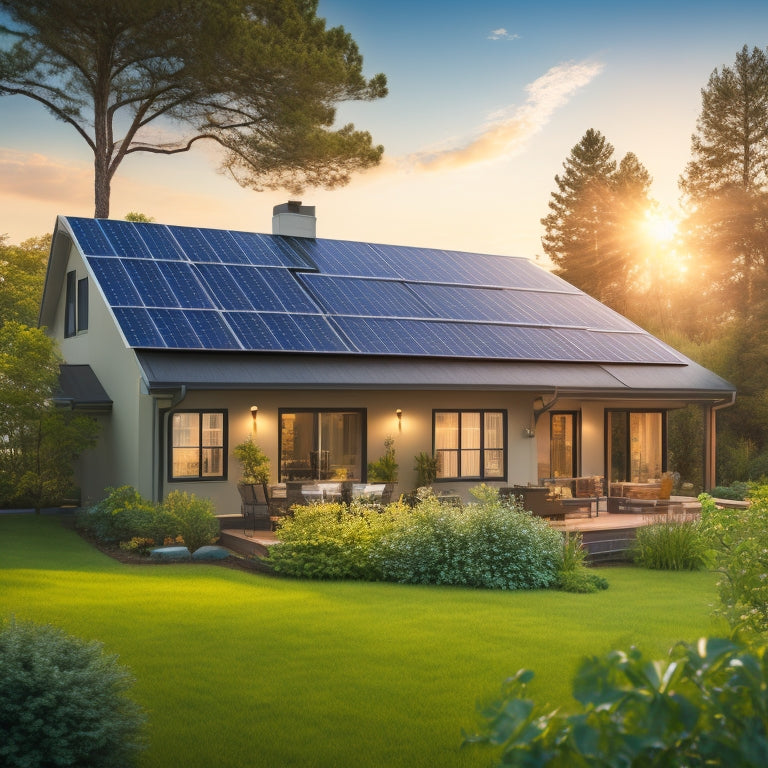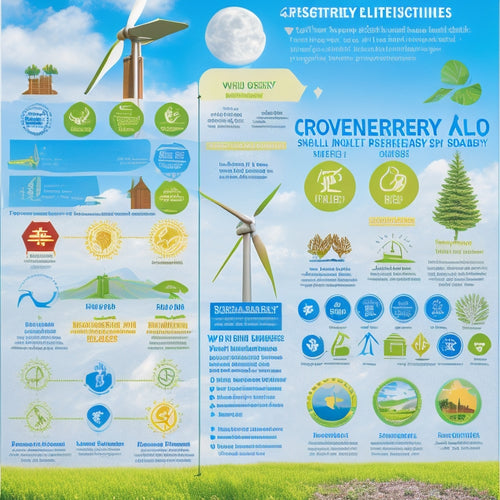
Key Considerations for the Cost of Solar Power at Home
Share
When evaluating the cost of solar power at home, you'll need to take into account various key factors. These include the type and quality of solar panels, installation methods, and financing options, as well as roof size and orientation, energy efficiency, and usage patterns. System size and quality, installation and labor costs, local incentives, and rebates also play a significant role. Additionally, maintenance and repair expenses, backup power capacity, and energy storage options should be factored in. To get an accurate estimate, it is crucial to assess these factors and how they interact, which you can do by exploring each component in more detail.
Key Takeaways
- Understanding solar panel costs involves considering types, installation methods, financing options, and long-term savings to make an informed decision.
- Roof size and orientation significantly impact energy production, with south-facing roofs between 30-40 degrees being ideal for maximum efficiency.
- Energy efficiency and usage patterns affect system size and cost, making it essential to conduct a household energy audit and develop conservation strategies.
- System size and quality impact upfront costs, with larger systems producing more electricity and high-quality systems offering better performance and longer lifespans.
- Local incentives, rebates, and financing options can significantly reduce solar power installation costs, making it crucial to research and explore available programs.
Understanding Solar Panel Costs
Your solar power journey begins with understanding the costs associated with installing solar panels. You'll need to evaluate the type of solar panels, installation methods, and financing options that fit your budget. The cost of solar panels varies depending on the type, with monocrystalline and polycrystalline being the most common.
Installation methods, such as roof-mounted or ground-mounted, also impact the overall cost. Fortunately, financing options like loans and power purchase agreements can help make solar energy more accessible.
Beyond the upfront costs, assess the long-term savings and environmental benefits of solar power. You'll enjoy energy independence, reduced reliance on the grid, and lower utility bills.
Technology advancements have improved the performance and efficiency of solar panels, ensuring maximum energy output. Performance monitoring systems track your energy production, and warranty coverage provides peace of mind.
With the right combination of solar panel types, installation methods, and financing options, you can utilize the power of the sun and start saving today.
Roof Size and Orientation Matters
As you contemplate the type and installation method of your solar panels, it's equally important to evaluate the roof that will be hosting them. The size and orientation of your roof plays a significant role in determining the effectiveness of your solar power system. A larger roof with minimal shading allows for more panel placement options, increasing energy production.
However, roof shading from trees, chimneys, or surrounding structures can reduce energy output. The ideal roof orientation for solar panels is south-facing, with an angle between 30-40 degrees to maximize energy production. Seasonal variations in sunlight intensity also impact energy output, so it's vital to assess your local weather patterns.
Installation access is another critical factor, as difficult-to-reach areas can increase installation costs. Additionally, the type of roof materials and structural integrity can affect the installation process and overall system durability.
A thorough assessment of your roof's size, orientation, and conditions will help you determine the most effective solar panel installation for your home.
Energy Efficiency and Usage
Energy consumption patterns greatly impact the efficacy of a solar power system, so it's crucial to assess your energy usage habits before installing solar panels.
You should identify areas where you can reduce energy consumption, as this will directly impact the size and cost of the solar power system you need. Conducting a household energy audit will help you pinpoint areas of inefficiency and opportunities for improvement.
This audit will assess your energy usage patterns, identifying appliances and systems that consume the most energy. With this information, you can develop energy conservation strategies to reduce your overall energy consumption.
System Size and Quality Impact
Since the size and quality of your solar power system directly impact its performance and cost, it is essential to understand how these factors influence your overall energy independence. A larger system will generally produce more electricity, but it also increases the upfront cost. On the other hand, a high-quality system with superior installation quality, warranty options, and material durability will provide better performance metrics and longer lifespan, although it may come at a higher cost.
| System Quality Factor | Impact on Cost and Performance |
|---|---|
| Brand Reputation | A reputable brand can increase cost, but guarantees high-quality components and better performance |
| Efficiency Ratings | Higher efficiency ratings increase energy production, but also raise the cost |
| Technology Advancements | Latest technology advancements can improve performance, but may add to the cost |
| Material Durability | Durable materials guarantee longer system lifespan, reducing replacement costs and increasing overall performance |
When evaluating system size and quality, consider your energy needs, budget, and desired level of energy independence. By balancing these factors, you can optimize your solar power system for maximum performance and cost-effectiveness.
Installation and Labor Costs
Across the board, installation and labor costs account for a significant portion of the overall expense of going solar, ranging from 10% to 20% of the total cost.
As you contemplate going solar, you'll need to factor in the costs associated with installing your new system. This includes the cost of labor, which can vary depending on the complexity of the installation, the size of the system, and the location of your home.
You'll also need to take into account the cost of installation permits, which can add up quickly. These permits are typically required by your local government and can range in cost from a few hundred to several thousand dollars.
Fortunately, many solar installers will handle the permitting process for you, which can simplify the process and reduce the overall cost.
When it comes to financing your solar installation, you'll have several options to choose from. You can pay cash upfront, take out a loan, or investigate financing options through your installer or a third-party provider.
Be sure to research your options carefully and choose the one that works best for your budget and financial situation.
Local Incentives and Rebates
You'll be pleased to know that there are various local incentives and rebates available to help offset the cost of solar power at home.
You can claim government tax credits, which can considerably reduce your upfront costs.
Additionally, you may be eligible for state rebate programs and utility company incentives, which can further sweeten the deal.
Government Tax Credits
As you maneuver the cost of solar power at home, taking advantage of government tax credits can greatly reduce your upfront investment. The federal government offers various incentives to encourage the adoption of solar energy, and you can benefit from these tax benefits.
| Tax Credit/Incentive | Description |
|---|---|
| Federal Solar Investment Tax Credit (ITC) | 26% of the total cost of your solar panel system, including equipment and installation |
| Residential Renewable Energy Tax Credit | 26% of the total cost of your solar panel system, including equipment and installation |
| Solar Renewable Energy Certificates (SRECs) | Varies by state, but can provide additional revenue through the sale of SRECs |
| Net Metering | Allows you to sell excess energy back to the grid and offset your energy bills |
These federal incentives can considerably reduce the cost of your solar panel system, making it more affordable and increasing your return on investment. By taking advantage of these tax benefits, you can enjoy the financial and environmental benefits of solar power while minimizing your upfront costs.
State Rebate Programs
Beyond federal incentives, state rebate programs offer additional financial benefits to homeowners investing in solar power. These programs vary by state, so it's crucial to check your state's eligibility and specific requirements.
You'll need to determine if you qualify for the rebate and verify your solar panel system meets the necessary standards. To take advantage of these programs, you'll need to submit a rebate application, which typically includes providing documentation, such as proof of purchase and installation, as well as system specifications.
Be prepared to provide detailed information about your solar panel system, including its size, type, and installation date. The rebate amount varies by state, but it can greatly reduce the upfront cost of your solar panel system.
Some states offer a flat rate per watt of installed capacity, while others provide a percentage of the total system cost. Research your state's program to understand the specific benefits and requirements.
Utility Company Incentives
Utility companies also offer incentives to homeowners who invest in solar power, providing additional financial benefits on top of federal and state programs. These incentives can greatly reduce the cost of solar power at home.
You may be eligible for special utility rate structures that allow you to sell excess energy back to the grid and offset your energy bills. Additionally, some utility companies offer demand response programs that reward you for reducing energy consumption during peak hours. This can lead to further savings on your energy bills.
When exploring utility company incentives, you'll want to research the specific programs available in your area. You may need to meet certain requirements, such as installing a smart meter or agreeing to participate in load management programs.
Be sure to review the terms and conditions of each incentive to verify it aligns with your energy needs and goals. By taking advantage of these local incentives and rebates, you can further reduce the cost of solar power at home and maximize your return on investment.
Maintenance and Repair Expenses
You'll be relieved to know that solar panels require minimal maintenance and repairing, which translates to lower expenses for you in the long run. This is because solar panels have fewer moving parts, reducing the likelihood of mechanical failures.
As a homeowner, you can focus on preventive maintenance, such as cleaning the panels regularly to guarantee peak energy production. The repair frequency is low, and most issues can be resolved through remote system monitoring and troubleshooting techniques.
Additionally, reputable manufacturers provide thorough warranty coverage, typically ranging from 25 to 30 years, which covers parts and labor costs. It's crucial to work with a trained technician who can identify potential issues early on, reducing downtime and repair costs.
With a well-maintained system, you can expect an equipment lifespan of 30 years or more. When conducting a cost analysis, consider the long-term savings on maintenance and repairs, which can greatly offset the initial installation cost.
Battery Backup and Storage Needs
You'll need to evaluate your backup power capacity when selecting a battery storage system, as it will determine how much electricity you can access during an outage.
You'll also need to choose from various energy storage options, such as lead-acid, lithium-ion, or flow batteries, each with its own set of benefits and drawbacks.
Backup Power Capacity
Your solar power system's backup power capacity is essential during extended grid outages or periods of high energy demand.
You'll need a reliable backup system to guarantee your home remains powered when the grid is down. This is where battery backup and storage come into play. The size and type of battery you choose will directly impact your system's backup power capacity.
When selecting a battery, consider its battery life, which is typically measured in cycles. A cycle represents one full discharge followed by a full recharge. Look for batteries with a high cycle life to guarantee they can handle frequent charging and discharging.
You should also consider the depth of discharge (DOD), which is the percentage of the battery's capacity that's used before recharging. A higher DOD means more energy is available during an outage.
Your backup system's capacity will also depend on your energy usage patterns. If you have high-energy appliances or a large home, you'll need a more sturdy backup system to meet your energy demands.
Energy Storage Options
As grid outages become more frequent, homeowners are turning to energy storage options to guarantee a reliable supply of power.
You're likely considering energy storage technologies to complement your solar panel system, ensuring you have power when you need it most. There are several solar battery types to choose from, each with its own advantages and disadvantages.
Lead-acid batteries are a cost-effective option, but they're heavier and less efficient than other types.
Lithium-ion batteries, on the other hand, are more expensive, but they're lighter, more efficient, and have a longer lifespan. Other options include nickel-cadmium and sodium-ion batteries, each with its own unique characteristics.
When selecting an energy storage system, consider your storage needs, budget, and the type of power you need.
Do you want to power your entire home or just essential appliances? Do you need a backup system that can provide power during extended outages? Answering these questions will help you determine the best energy storage solution for your solar power system.
Frequently Asked Questions
Can I Install Solar Panels on a Metal or Tile Roof?
You can install solar panels on metal or tile roofs, but you'll need to guarantee the roof's structural integrity and meet specific installation requirements, such as securing panels to the roof type's unique features, like metal seams or tile hooks.
Do Solar Panels Work During a Power Outage?
You're wondering if solar panels work during a power outage. Unfortunately, they don't, unless you have solar battery storage, which allows you to access stored energy and maintain grid independence, ensuring you stay powered up even when the grid goes down.
Are Solar Panels Resistant to Hail and Extreme Weather?
You'll be relieved to know that 99% of solar panels can withstand hail up to 1 inch in diameter; they're designed with weather durability in mind, minimizing hail damage, so you can rely on them even in extreme weather conditions.
Can I Sell My Excess Solar Energy Back to the Grid?
You can sell excess solar energy back to the grid through net metering, benefiting from energy buyback rates, which vary by utility company, and receive credits on your bill, offsetting your energy consumption when you need it.
Do Solar Panels Void My Roof Warranty?
You're finally going green, but wait, will solar panels sabotage your roof warranty? Ironically, it's the installation, not the panels, that might void your warranty. Check your roof warranty's fine print for installation method implications before going solar.
Conclusion
As you commence your solar power expedition, remember that the cost of utilizing the sun's energy is like steering through a scenic route. You'll encounter twists and turns, like roof size and orientation, energy efficiency, and system quality. But with each step, you'll inch closer to your destination - a sustainable, cost-effective energy solution. Keep your eyes on the horizon, and don't let installation, labor, and maintenance costs cloud your vision. With the right map, you'll arrive at a brighter, more affordable energy future.
Related Posts
-

Innovative Sustainable Materials for Energy-Efficient Homes
Innovative sustainable materials enable you to create energy-efficient homes while promoting environmental responsibi...
-

Renewable Energy Certifications for Businesses
Renewable energy certifications are essential for your business, showcasing your commitment to sustainability and enh...
-

Energy-Efficient Home Upgrades for Cost Reduction
To reduce costs with energy-efficient home upgrades, focus on essential improvements like smart thermostats, energy-e...


